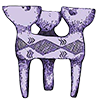Visions of Raising the Republic in the Province: A Discursive Reading of Childhood, Motherhood, and National Ideals in the Gediz Journal of Early Republican Manisa
DOI:
https://doi.org/10.33831/jws.v26i1.532Keywords:
Childhood, Motherhood, Nation-building, Early Republican Turkey, ManisaAbstract
Childhood, as a socially constructed category, is shaped by specific cultural, political, and historical contexts, and is neither static nor universal. In many nation-building efforts, including that of early Republican Turkey, it has been redefined as a discursive tool to serve the needs of the regime. This study focuses on how childhood was constructed and what values were ascribed to children in the Western Anatolian town of Manisa. Using thematic and discourse analysis and adopting a micro-historical lens, it examines how the Gediz Journal of the Manisa People’s House (1937–1950) engaged with dominant narratives of childhood. The main findings of the study are as follows: 1) the issue of children in Gediz intersected with broader ideological goals of modernization, nation-building, population politics, and gender roles, and it was articulated in ways that reflected these agendas; 2) Children were depicted as vital assets to the nation-state and imagined as future citizens entrusted with ensuring its continuity; 3) The family and the school emerged as the two primary institutions tasked with this mission, with mothers positioned as the principal nurturers expected to raise the future of the Republic; 4) While the journal localized many topics—such as Manisa’s history, folklore, urban development, and socio-economic concerns—its treatment of children reflected a top-down, state-driven narrative. Emphasis was placed on children’s physical, mental, and moral development to safeguard the Republic’s ideological continuity through the combined efforts of the family, especially mothers, and the state. By centering its analysis on childhood, this article questions the descriptive tendency prevalent in existing scholarship on People’s House publications by focusing specifically on the Gediz journal. It underscores the need for critically engaged and localized readings to develop a more comprehensive understanding of how nation-building, modernity, and gender norms were constructed and disseminated in the early Republican period.
References
Bayer, F. (1943). 23 Nisan ve çocuk. Gediz Dergisi, (63): 1-3.
Bayçın, N. (1945). Çocuğun değeri. Gediz Dergisi, (80): 10- 11.
Bayçın, N. (1946). Türk gençlerine mutlaka okuyacakları şaheserleri belirtmek lâzım. Gediz Dergisi, (93):3-4.
Dümer, M. (1937). Ah, Bir Lise … Gediz Dergisi, (3): 1-3.
Dümer, M. (1938). Gediz Bir Yaşında, Gediz Dergisi, (12): 1-2.
Duru, K. N. (1940). Çocuk haftası münasebetiyle. Gediz Dergisi (37): 7-8.
Ertürk, Ahmet (AE). Çocuk. Gediz Dergisi, (49): 1-2.
Gediz. (1937a). Niçin Gediz? Gediz Dergisi, (1): 1-2.
Gediz. (1937b). Gedizlilere. Gediz Dergisi, (1):16.
Gediz. (1937c). Kutal Gün, Gediz Dergisi, (7): 1-2.
Gediz. (1950). Tekrar çıkıyoruz. Gediz Dergisi, (103): 1.
Gökalp, Z. (1941). Türk İnkılâbında Türk kadının hukîkî ve içtimâî mevkii. Gediz Dergisi, (54): 6-7.
Gökçe, O. R. (1940). Türk kadını, Türk kızı vazife başına. Gediz Dergisi, (43): 2-3.
Hızal, M. (1943). 19 Mayıs ve gençlik. Gediz Dergisi, (64): 1-2.
Karasu, A. (1937a). Türk anası. Gediz Dergisi, (6): 5-7, 14.
Karasu, A. (1937b). Türk anası. Gediz Dergisi, (7): 3-7.
Karasu, A. (1937c). Türk anası. Gediz Dergisi, (8):10-12.
Kaynak, Y. (1937). Aile içinde çocuk. Gediz Dergisi, (4): 1.
Orhon, O. H. (1946). Çocuk sağlığı. Gediz Dergisi, (94): 9-12.
Oskay, B. (1941). Tarihî tetkikler, eski boşanmalar. Gediz Dergisi, (49):11-13.
Önakın, A. Gediz ve Gediz Okuyucularına Veda. Gediz Dergisi, (94): 4.
Önakın, A. (1943) Gediz ve Biz, Gediz Dergisi, (62): 1-2.
Önertürk, A. (1941). Yurt ve çocuk. Gediz Dergisi (49): 1-2.
Önoğur, C. (1942a). Aile ile okul iş birliği. Gediz Dergisi, (55): 7-10.
Önoğur, C. (1942b). Aile ile okul iş birliği. Gediz Dergisi (56): 8-11.
Özses, K. (1945). Dertlerimiz: Su. Gediz Dergisi, (86): 3-5.
Özses, K. (1946). Dertlerimiz: Elektrik. Gediz Dergisi, (92): 3-4.
Sezgin, C. Bibliografya, Gediz Dergisi, (41): 12-14.
Sümerman, S. (1937a). Gediz çıkarken. Gediz Dergisi, (1): 11-12.
Sümerman, S. (1937b). Çocuk bayramının ilhamları. Gediz Dergisi, (2): 14-15.
Turanlı, M. (1937). Çocuk bayramı. Gediz Dergisi, (1): 7-8.
Uluçay, C. (1937a). Manisa’nin istekleri. Gediz Dergisi, (1): 5-7.
Uluçay, C. (1937b). Manisa’nin sembolleri. Gediz Dergisi, (5): 5-7.
Alemdaroğlu, A. (2005). Politics of the body and eugenic discourse in Early Republican Turkey. Body & Society, 11 (3): 61-76.
Arat, Y. (1997). The project of modernity and women in Turkey. In S. Bozdağan & R. Kasaba (Eds.), Rethinking modernity and national identity in Turkey (pp. 95–112). Washington, DC: University of Washington Press.
Ariès, P. (1962). Centuries of childhood (R. Baldick, Trans.). London: Jonathan Cape.
Barut, M. (1993). Dr. Reşit Galip Zamanı ve Düşünce Sistemi (Master's thesis, Marmara Universitesi).
Başboğa, S. (2018). Erken Cumhuriyet dönemi çocuk dergilerinde bedeni, ahlaki ve terbiyevi özellikleriyle inşa edilen çocuk (Doctoral dissertation, Yıldız Teknik University).
Bilgi, N. (2001). Yeni Doğuş: Manisa Halkevi Dergisi. Atatürk Araştırma Merkezi Dergisi, 17 (49):131–157.
Bilgi, N. (2022). 1922 Manisa büyük yangını: Harîk-i Hâil. Celal Bayar Üniversitesi Sosyal Bilimler Dergisi, 20 (Special Issue): 231–251.
Brockliss, L. (2016). Introduction: The Western concept of childhood. In B. C. Fortna (Ed.), Childhood in the Late Ottoman Empire and After (pp. 1–17). Leiden: Brill.
Çakır, G. (2019). Atatürk döneminde kadın, çocuk ve aile algısı (Doctoral dissertation, Dokuz Eylül Üniversity).
Çeçen, A. (1990). Atatürk’ün kültür kurumu Halkevleri. İstanbul: Gündoğan Yayınları.
Çiçek, N. (2012). Erken Cumhuriyet döneminde modern çocukluk nosyonunun görünümleri üzerine bir analiz. Mülkiye Dergisi, 36(4): 69–104.
Çiçek, N. (2016). The interplay between modernization and the reconstruction of childhood: Romantic interpretations of the child in early Republican era popular magazines, 1924–1950. In B. C. Fortna (Ed.), Childhood in the Late Ottoman Empire and After (pp. 19–47). Leiden: Brill.
Çiçek, N. (2020). Erken cumhuriyet döneminde kimsesiz çocuklar olgusuna dair bir vaka takdimi ve analizi. Ankara Üniversitesi Dil ve Tarih-Coğrafya Fakültesi Dergisi, 60 (2): 958–988.
Çetin, S. (2012). Geç Osmanlıdan erken Cumhuriyete iç Batı Anadolu’da kentsel yapının değişimi: Manisa, Afyon, Burdur ve Isparta kentleri üzerine karşılaştırmalı bir inceleme. ODTÜ Mimarlık Fakültesi Dergisi, 29(2): 89–126.
Çetinalp, S. (2019). Gediz dergisinin halk bilimsel tahlili (Master's thesis, Manisa Celal Bayar University).
Emecen, F. (2003). Manisa. Türkiye Diyanet Vakfı İslam Ansiklopedisi, I. Retrieved from https://islamansiklopedisi.org.tr/manisa#1
Ersanlı, B. (2018). İktidar ve Tarih: Türkiye'de" Resmi Tarih" Tezinin Oluşumu (1929-1937). Ankara: İletişim Yayınları.
Ertem, Ö. (2005). The republic's children and their burdens in 1930s and 1940s Turkey: The idealized middle-class children as the future of the nation and the image of poor children in children’s periodicals (Master's thesis, Boğaziçi Üniversity).
Gencer, Y. (2012). We are family: The child and modern nationhood in early Turkish Republican cartoons (1923–1928). Comparative Studies of South Asia, Africa and the Middle East, 32(2), 294–309.
Güneş, G., & Güneş, M. (2007). Cumhuriyet döneminde Manisa’nın sosyo-kültürel yaşamında Halkevi’nin yeri ve önemi. Çağdaş Türkiye Tarihi Araştırmaları Dergisi, 6(15): 55–72.
Kandiyoti, D. (1987). Emancipated but unliberated? Reflections on the Turkish case. Feminist studies, 13(2):317-338.
Kandiyoti, D. (1997). Gendering the Modern: On Missing Dimensions in the Study of Turkish Modernity.In In S. Bozdağan & R. Kasaba (Eds.), Rethinking Modernity and National Identity in Turkey (pp. 113-132). Washington, DC: University of Washington Press.
Karaömerlioğlu, M. A. (1998). The people’s houses and the cult of the peasant in Turkey. Middle Eastern Studies, 34(4):67–91.
Karpat, K. H. (1963). The People's Houses in Turkey: Establishment and growth. Middle East Journal, 17(1/2): 55–67.
Karpat, K. H. (1974). The impact of the People's Houses on the development of communication in Turkey: 1931-1951. Die Welt des Islams, 15(1/4): 69–84.
Kılınç, V. (2017). Disciplining Turkish people through the people's houses: A discursive reading of the Ülkü magazine (1933-1950) (Master's thesis, Istanbul Şehir University).
Lamprou, A. (2009). Between central state and local society: The People’s Houses Institution and the domestication of reform in Turkey (1932-1951) (Doctoral dissertation, Leiden).
Lamprou, A. (2015). Nation-building in modern Turkey: The “People’s Houses,” the state, and the citizen (1st ed.). London: I.B. Tauris.
Libal, K. (2000). The Children’s Protection Society: Nationalizing child welfare in early Republican Turkey. New Perspectives on Turkey, (23): 53–78.
Morrison, H. (Ed.). (2013). The global history of childhood reader. London: Routledge.
Onur, B. (2009). Türk modernleşmesinde çocuk. Ankara:İmge Kitabevi Yayınları.
Öztamur, P. (2004). Defining a population: Women and children in early republican Turkey, 1923-1950 (Master’s Thesis, Bogazici University).
Öztan, G. G. (2013). Türkiye'de çocukluğun politik inşası. İstanbul: İstanbul Bilgi Üniversitesi Yayınları.
Öztan, G. G. (2011). Türkiyede çocukluğun politik inşası (Doctoral Dissertation, Istanbul University).
Öztürkmen, A. (1994). The role of People’s Houses in the making of national culture in Turkey. New Perspectives on Turkey, (11): 159–181.
Stearns, P. N. (2016). Childhood in world history. London: Routledge.
Şakiroğlu, M. H. (1996). Halkevi dergileri ve neşriyatı. Kebikeç, (3): 131-142.
Şen, M. (1992). Manisa Halkevi’nin çalışmaları ve dergileri (Master’s thesis, Dokuz Eylül Üniversity).
Şen, M. (1996). Manisa Halkevi yayınları ve yerel tarih çalışmaları örneği. Çağdaş Türkiye Tarihi Araştırmaları Dergisi, 2(6), 147-156.
Şimşek, S. (2005). “People’s Houses” as a nationwide project for ideological mobilization in early Republican Turkey. Turkish Studies, 6(1):71–91.
Toprak, Z. (2017). Erken Cumhuriyet, nüfus sorunu ve çocuk ölümleri. Toplumsal Tarih, (281): 22–31.
Tunç, Y. (2016). Mental hygiene, puericulture, and cultural politics of childhood in Turkey, 1920s to 1950s: Reforming the nation through reforming the mind and body of the child. (Doctoral dissertation, The University of Wisconsin-Madison).
Türkçapar Günay, N. (1999). Gediz bibliyografyası. İzmir: Akademi Kitabevi.
Yolcu Yavuz, S. (2019). Cumhuriyet misyonerleri: 1930–1946 arası Türkiye’de bir politik özne olarak gençlik inşası. Vakıf Bank Kültür Yayınları.
Published
Issue
Section
License
Copyright (c) 2025 Kadın/Woman 2000, Journal for Women's Studies

This work is licensed under a Creative Commons Attribution-NonCommercial 4.0 International License.
Authors who publish with this journal agree to the following terms:
- Authors retain copyright and grant the journal right of first publication, with the work [6 months] after publication simultaneously licensed under a Creative Commons Attribution License that allows others to share the work with an acknowledgement of the work's authorship and initial publication in this journal.
- Authors are able to enter into separate, additional contractual arrangements for the non-exclusive distribution of the journal's published version of the work (e.g., post it to an institutional repository or publish it in a book), with an acknowledgement of its initial publication in this journal.
- Authors are permitted and encouraged to post their work online (e.g., in institutional repositories or on their website) prior to and during the submission process, as it can lead to productive exchanges, as well as earlier and greater citation of published work (See The Effect of Open Access)






